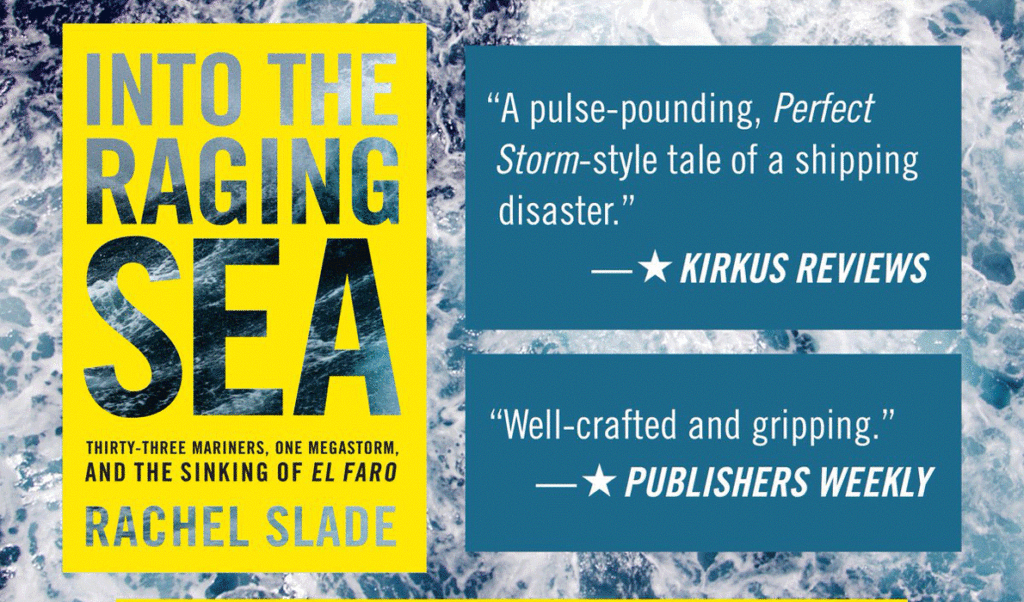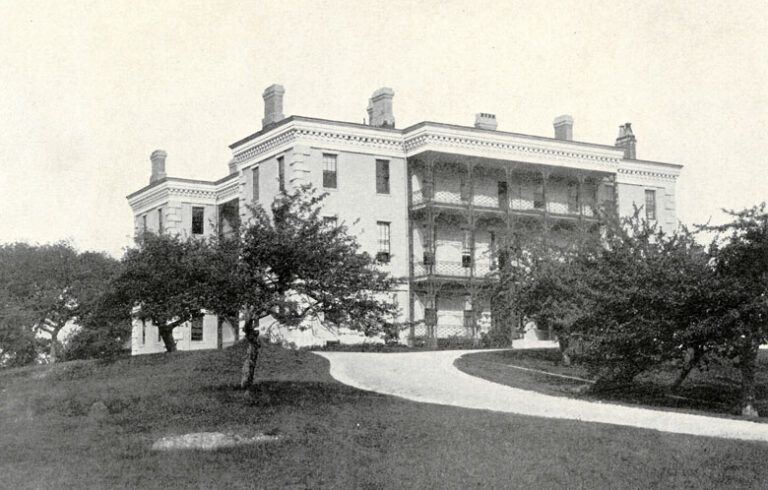Into the Raging Sea: Thirty-Three Mariners, One Megastorm, and the Sinking ofEl Faro
By Rachel Slade (HarperCollins, 2018)
Reviewed by Tina Cohen
In October 2015, the El Faro, a 790-foot American container ship owned and operated by TOTE Maritime, sank off the Bahamas, claiming the lives of all 33 crew, including four from Maine. The ship was enroute fully loaded with consumer goods to San Juan, Puerto Rico as Hurricane Joaquin bore down on the Carribean.
The tragedy is re-created and injected with all its dramatic human experience in Rachel Slade’s Into The Raging Sea, relying on transcripts of recordings of the final 26 hours of conversation on the ship’s bridge, saved by the vessel’s “black box.” Slade also draws on numerous interviews with crew family members.
In this era of sophisticated technology, how could a cargo ship sink? What human and mechanical failings undermined the safe outcome? Don’t ships get weather forecasts, can’t they change their route to avoid a storm? Wouldn’t El Faroneed to be in good working condition? Wasn’t this a route and ship familiar to many of the crew on board? The National Transportation Safety Board asked the same questions.
Human shortcomings were highlighted in the NTSB’s analysis, determining Capt. Michael Davidson’s decisions, as well as corporate TOTE’s poor oversight and inadequate safety management system, led to the disaster. Weather reports were hours out of date and Davidson inexplicably delayed accessing them.
Joaquin proved fickle, first about turning from a tropical storm into a hurricane, and then about its track. But even with more timely forecasts shared with him by crew, along with suggestions of altering course, Davidson was hearing none of it.
Ultimately, U.S. Coast Guard warnings came, sounding a serious alarm. The captain is recorded as uttering a “Wow” in response, but still did not change course. He repeatedly assured crew on the bridge that they would be fine. He left the bridge for his cabin for eight hours as the ship pitched viciously and blindly in the wind-driven waves. Sleep would have been difficult if not impossible. What did he do during that time?
It is tempting to imagine he may have composed a report to send to TOTE or the Coast Guard, a whistle-blowing last ditch effort to identify El Faro’s many failings. But could he have recognized his own?
In a phone interview, Slade said she believes Davidson had become obsessed with proving himself, having no sense of job security with TOTE. Davidson understood from recent corporate communications that he had been passed over for the upgrade to captain of one of two new ships due to replace El Faroand its sister ship, El Morro. If he stayed on, he would remain with the second-rate ship; he may have felt bitter.
Davidson had not gotten high marks on leadership qualities in interactions with crew, but he had demonstrated care for safety in the past. Not risking his crew and ship by opting for a safer route in an earlier storm, Davidson believed, disadvantaged him in the hiring competition.
El Farowas scheduled for an overhaul and reassignment to routes in the Pacific Northwest, far from Davidson’s family and home in Maine. On that final voyage, Davidson seemed deep in denial about the raging sea and the threat the storm posed. In rejecting an option suggested by second mate Danielle Randolph, he instead positioned the ship to take 40-foot-high waves broadside while in 100 mile-per-hour sustained winds.
The recording indicates he was sure things were under control; his call to the crew to muster and finally abandon ship came at an unreasonably late moment. “Wow” indeed; one wonders how the severity of the situation didn’t register. Slade believes the bad decisions most likely came from experiencing a tremendous amount of pressure from TOTE, including expectations for timely delivery, fuel efficiency, and no overtime expenses. Arguably, they prioritized maximizing profits while spending little on boat maintenance and crew support.
El Farotook on water, lost propulsion, and sank, coming to rest on the ocean bottom at 15,000 feet. None of the 33 crew were rescued or recovered. After a harrowing and dogged search months later, the voice and data recordings were located and retrieved—a chip smaller than a credit card inside a container the size of a basketball.
Slade shares evocative portraits of crew members. For those of us a part of the coastal Maine community—Slade has a home in Rockport—her descriptions introduce us to those drawn to a mariner’s life, including study at the Maine Maritime Academy in Castine. Five of the crew had that connection, including Capt. Davidson.
Danielle Randolph, second mate, lived in Rockland and was 34 years old. She is heard on the recording using gallows humor to press her question—why were they sailing straight into a hurricane? Her disbelief at a captain unwilling to listen highlights what the NTSB concluded, faulting El Faro’sbridge resource management. Ships historically observe a rigid hierarchy where captains have the ultimate authority; they don’t have to take advice, collaborate, or acknowledge they need more information or might be wrong. But the NSTB suggested TOTE should have implemented an approach in which crew on the bridge had more participation.
TOTE also saw the captain as the primary nautical expert and provided no additional oversight from land. For El Faro, this meant no tracking of the ship during the storm and no support to consider the captain’s decision-making. TOTE also was cited for not providing officers and crew with necessary procedures to ensure the vessel’s watertight integrity, heavy weather preparedness, and emergency response. There were only open lifeboats, not modern enclosed ones. By the time the crew was abandoning ship, it appears El Faro’swere unable to be boarded and launched.
Into the Raging Seaalso covers maritime and naval history, shipbuilding, government oversight, a flavor of life on board a container ship, the science of hurricanes and weather forecasts, the shipping industry and where it is headed, and lessons learned. As comprehensive and detailed as it is, Slade’s book is also a compelling story, hard to put down. I hope Slade’s passion and hard work not only have a pay-off with readers, but with pointing to needed changes.
Tina Cohen is a seasonal resident of Vinalhaven.





